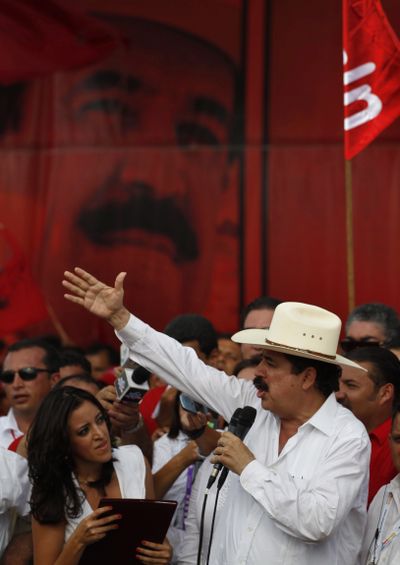Former Honduran leader returns after forced exile
Nation on track to normalization

TEGUCIGALPA, Honduras – Ousted former Honduran President Manuel Zelaya returned from exile on Saturday to a boisterous welcome from his supporters, ending a nearly two-year political crisis that started when the country’s military deposed him in an internationally condemned coup.
The Venezuelan-owned plane carrying the 59-year-old ex-president took off from neighboring Nicaragua and landed in the afternoon at Tegucigalpa’s international airport, where thousands of his supporters had set up a tent camp nearby, dancing and singing to celebrate his arrival.
Zelaya’s comeback in an internationally brokered agreement paves the way for Honduras to re-enter the world community, which near-unanimously rejected the June 2009 coup that saw him whisked out of the country at gunpoint in his pajamas. The Organization of American States is scheduled to consider Honduras’ full reintegration into the hemispheric body on Wednesday.
Wearing his trademark white, wide-brimmed hat, Zelaya called for an end to coups in the impoverished Central American country and urged his cheering supporters to carry out only “peaceful resistance.”
“The problem of poverty, of corruption, of the great challenges of Latin American societies won’t be resolved through violence, but through more democracy,” Zelaya told supporters after a motorcade took him from the airport to a nearby plaza.
The ex-president also supported the idea of a constituent assembly to reform the constitution, an idea that led to his original ouster.
Zelaya was accompanied on the flight by his wife, two of his daughters, several former officials in his government, ex-Panamanian President Martin Torrijos and the foreign ministers of Venezuela and Bolivia, countries with leftist governments that have backed Zelaya.
The OAS, Colombia and Venezuela supervised Zelaya’s safe return, 23 months after he was removed by the military for ignoring a Supreme Court order to cancel a referendum asking Hondurans if they favored changing the constitution.
His detractors claimed he wanted to hijack the democratic process to enable his re-election.
After he was deposed, everyone from the U.S. to the OAS tried to broker Zelaya’s return to finish out his term. He holed up in the Brazilian Embassy in the capital, Tegucigalpa, for three months until after Porfirio Lobo won the regularly scheduled presidential election and took office in January 2010. Lobo allowed Zelaya safe passage out of the country to the Dominican Republic.
Many Latin American countries refused to recognize Lobo’s democratically elected government until the Zelaya issue was resolved.
The deal to bring Zelaya back to Honduras – called the Cartagena accord because it was unveiled in the Colombian city – didn’t call for an immediate return to power.
“The Cartagena agreement has only one message: no more coup d’etats in Honduras and in Latin America,” Zelaya said.
Zelaya returns to a country that has since enacted many of the changes he advocated.
His idea of holding a referendum to amend the constitution – the final straw that led to the coup – is now a law.
An agreement signed last week that makes way for Zelaya’s safe return will also allow him to form his own political party and potentially end Honduras’ long-standing and rigid two-party system.